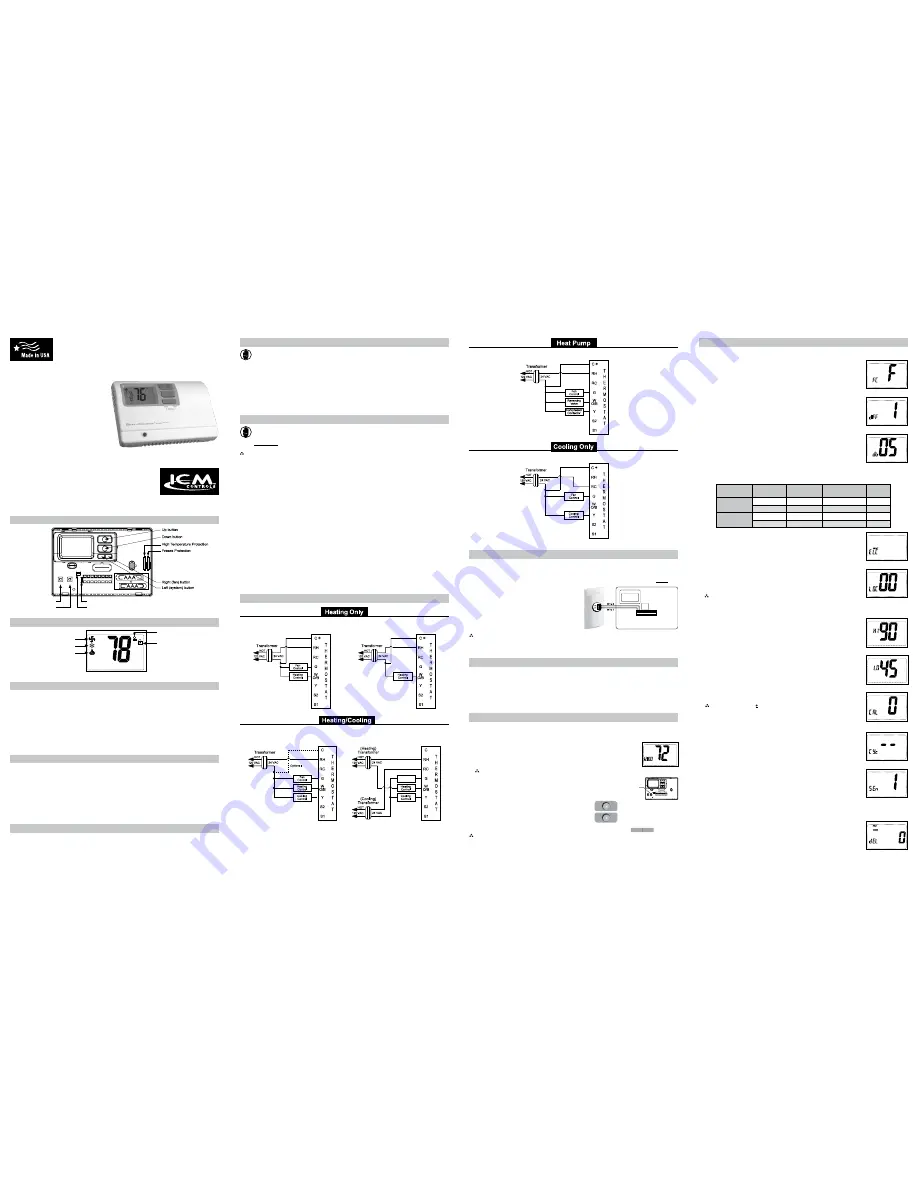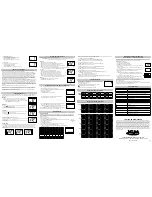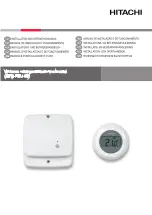
Installation, Operation & Application Guide
For more information on our complete range of American-made
products – plus wiring diagrams, troubleshooting tips and more,
visit us at
www.icmcontrols.com
Package Contents/Tools Required
Package includes:
SC5010 PRO
thermostat on base, thermostat cover, wiring labels, screws and wall anchors, 2
“AAA” batteries, Installation, Operation and Application Guide
Tools required for installation:
Drill with 3/16” bit, hammer, screwdriver
To Remove Existing Thermostat
ELECTRICAL SHOCK HAZARD
– Turn off power at the main service panel by removing the fuse
or switching the appropriate circuit breaker to the OFF position before removing the existing
thermostat.
1. Turn off power to the heating and cooling system by removing the fuse or switching the appropriate circuit
breaker off.
2. Remove cover of old thermostat. This should expose the wires.
3. Label the existing wires with the enclosed wire labels before removing wires.
4. After labeling wires, remove wires from wire terminals.
5. Remove existing thermostat base from wall.
6. Refer to the following section for instructions on how to install this thermostat.
1 Heat/1 Cool
Auto Changeover
Battery or Hardwire
SC5010
Programmable Electronic Thermostat
• 7-Day, 5-2-Day or 5-1-1-Day Programmable
• Configurable
• Single Stage Heat/Cool Systems
• Single Stage Heat Pump Systems
• Large Display With Backlight
• Selectable Fahrenheit or Celsius
• Compatible with Gas, Oil, or Electric
• SimpleSet™ Field Programming
• Status Indicator Light
• Relay Outputs
(minimum voltage drop in thermostat)
• Remote Sensor Compatible
• Ideally Suited for:
– Residential (New Construction/Replacement)
– Light Commercial
Parts Diagram
Configuration switch
Reset switch
Field programming pins
RC/RH Jumper
RC
G
W
O/B
Y
S2
S1
C
RH
CONFIG
RESET
FP
RC
RH
Icon Descriptions
Cooling operation icon
Fan operation icon
Heating operation icon
Lock mode activated
Room temperature
offset activated
Important Safety Information
WARNING!
:
Always turn off power at the main power supply before installing, cleaning, or removing
thermostat.
• This thermostat is for 24 VAC applications only; do not use on voltages over 30 VAC
• Do not short across terminals of gas valve or system control to test operation; this will damage your thermostat
and void your warranty
• All wiring must conform to local and national electrical and building codes
• Do not use air conditioning when the outdoor temperature is below 50 degrees; this can damage your A/C system
and cause personal injuries
• Use this thermostat only as described in this manual
Specifications
Electrical rating:
• 24 VAC (18-30 VAC)
• 3.0 VDC (2 “AAA” batteries)
• 1 amp maximum per terminal
• 3 amp maximum total load
Temperature control range:
45°F to 90°F (7°C to 32°C)
Accuracy:
± 1°F (± 0.5°C)
System configurations:
1-stage heat, 1-stage cool, heat pump, gas, oil, electric
Timing:
Anti-short Cycle: 4 minutes
Backlight Operation: 5 seconds when configured ON
Terminations:
S1, S2, Y, W/O/B, G, RC, RH, C
Hardwired
5-Wire, Two Transformer
(Both transformers must be in phase)
Hardwired
4 or 5-Wire, Single Transformer
Fan
Control
IMPORTANT
: Before wiring, remove pre-installed
RC/RH jumper.
To Install Thermostat
ELECTRICAL SHOCK HAZARD
– Turn off power at the main service panel by removing the fuse
or switching the appropriate circuit breaker to the OFF position before removing the existing
thermostat.
IMPORTANT:
Thermostat installation must conform to local and national building and electrical codes and
ordinances.
Note:
Mount the thermostat about five feet above the floor. Do not mount the thermostat on an outside wall, in
direct sunlight, behind a door, or in an area affected by a vent or duct.
1. Turn off power to the heating and cooling system by removing the fuse or switching the appropriate circuit
breaker off.
2. To remove cover, pull gently at the seam at the top.
3. Put thermostat base against the wall where you plan to mount it (Be sure wires will feed through the wire opening
in the base of the thermostat).
4. Mark the placement of the mounting holes.
5. Set thermostat base and cover away from working area.
6. Using a 3/16” drill bit, drill holes in the places you have marked for mounting.
7. Use a hammer to tap supplied anchors in mounting holes.
8. Align thermostat base with mounting holes and feed the control wires through slit in thermal intrusion barrier and
into wire opening.
9. Use supplied screws to mount thermostat base to wall.
10. Insert stripped, labeled wires in matching wire terminals.
CAUTION!
:
Be sure exposed portion of wires does not touch other wires.
11. Gently tug wire to be sure of proper connection. Double check that each wire is connected to the proper
terminal.
12. Insert 2 “AAA” batteries into battery holder. Orient them in the proper direction.
13. Turn on power to the system at the main service panel.
14. Configure thermostat to match the type of system you have.
15. Replace cover on thermostat by snapping it in place.
16. Test thermostat operation as described in “Testing the Thermostat”.
Wiring Diagrams
Hardwired
3-Wire, Single Transformer
Hardwired
4-Wire, Single Transformer
* Common wire connection
optional with batteries
installed.
Hardwired – Cool or Heat Active Reversing Valve
Hardwired – 4-Wire, Single Transformer
Configuration Mode Settings
The setup screens for Configuration Mode are as follows:
2.
Temperature Differential (1°F to 5°F) (0.5°C to 2.5°C) –
Set the number of degrees
between your “setpoint” temperature and your “turn on” temperature.
Press the
up
or
down
button to set differential value.
Press the
right
button to advance to the next screen.
1.
Temperature Scale (F or C) –
Choose Fahrenheit or Celsius.
Press the
up
or
down
button to select.
Press the
right
button to advance to the next screen.
3.
Deadband (1°F - 9°F) (1°C - 5°C) –
Set the minimum number of degrees between your
heat set temperature and your cool set temperature in Auto changeover mode.
Press the
up
or
down
button to set deadband value.
Press the
right
button to advance to the next screen.
Installing and Changing Batteries
If your LCD is blank, or displaying
LO BAT
, the batteries are not installed or need to be changed. We suggest you
change the batteries at least once a year, or whenever the
LO BAT
warning displays.
Remove the cover, and install the two “AAA” alkaline batteries into the battery compartment. Proper battery
installation is important! Make sure the positive ends of the batteries match the positive terminals in the battery
compartment.
Batteries will provide power to maintain the clock during a power loss.
Configuration Mode
OFF
PM
1. Verify the
SC5010
is in the
OFF
mode.
Press the
SYS
(left) button until off mode displays.
The configuration mode is used to set the
SC5010
to match your heating/cooling system. The
SC5010
functions
with heat pump, air conditioning, gas, oil or electric heat systems.
To configure the
SC5010
, perform the following steps:
2. Remove the cover of the thermostat by gently pulling near one of the
corners at the top of the thermostat.
Note:
Do not force open. Use a small coin or slotted screwdriver to release tabs if necessary.
Press the
up
or
down
button to change settings within each screen.
Down
button
Up
button
To exit configuration mode, press the
CONFIG
switch for 1 second.
Press the
right
button to advance to the next screen.
Note:
Pressing the
left
button will return you to the previous screen.
Left
button
Right
button
3. Press the
CONFIG
button for 1 second while the
SC5010
is in
OFF
mode.
CONFIG
5.
Lockout (0-8°, NITE, COOL-HEAT) –
Select the number of degrees set temperature
can be changed during keypad lockout or select to lockout during NITE period only.
COOL-HEAT lockout allows adjustment of the set temperatures to the maximum
heat set temperature selected in Step 6 and minimum cool set temperature selected in
Step 7.
Note:
The mode cannot be changed when the thermostat is locked.
Press the
up
or
down
button to select.
Press the
right
button to advance to the next screen.
Choose
System
Reversing
Valve Active
Number of Com-
pressors
Type of
Heat
Heat Pump
HP
O
1
HP
b
1
Non-Heat
Pump
Heat
Gas
Heat
Electric
Press the
up
or
down
button to select.
Press the
right
button to advance to the next screen.
4.
System –
Set for heat pump, non-heat pump, reversing valve operation and number of compressor in your
system
* Common wire connection
optional with batteries
installed.
* Common wire connection
optional with batteries
installed.
6.
Maximum Heat Setpoint
(45°F to 90°F) (7°C to 32°C)
Adjust to control the maximum heat set temperature allowed.
Press the
up
or
down
button to select.
Press the
right
button to advance to the next screen.
7.
Minimum Cool Setpoint
(45°F to 90°F) (7°C to 32°C)
Adjust to control the minimum cool set temperature allowed.
Press the
up
or
down
button to select.
Press the
right
button to advance to the next screen.
8.
Room Temperature Offset
(+9°F to -9°F) (+4.5°C to -4.5°C)
Adjust to calibrate displayed room temperature to match actual room temperature.
Note:
When not set to 0,
will display
Press the
up
or
down
button to select.
Press the
right
button to advance to the next screen.
9.
Maximum Cycles Allowed Per Hour
(- -, 2-6)
- - = as many as needed, 2-6 = maximum cycles/hour
Press the
up
or
down
button to select.
Press the
right
button to advance to the next screen.
OFF
11.
Cooling Fan Delay Off Time
(0, 30, 60, 90 seconds)
Select the fan purge time for cooling.
Press the
up
or
down
button to select.
Press the
right
button to advance to the next screen.
10.
Temperature Sensor
(1-4)
1. Only on-board sensor determines room temperature.
2. Only remote sensor determines room temperature.
3. Average temperature of on-board and remote sensor.
4. Only on-board sensor will be used until NITE period, and then only remote sensor
is used.
Press the
up
or
down
button to select.
Press the
right
button to advance to the next screen.
1. Remove cover from remote sensor housing.
2. Select an appropriate location for mounting the remote sensor.
3. Mount remote sensor unit using hardware provided.
4. Install two strand shielded wire between remote sensor and thermostat. Shielded wire must be used.
Do not
run
remote sensor wire in conduit with other wires.
•
Wire 1
should run between the S1 terminal on the
thermostat and the S1 terminal on the remote sensor
•
Wire 2
should run between the S2 terminal on the
thermostat and the S2 terminal on the remote sensor
• Connect the shielding of the wire to the S2 terminal on
the thermostat
5. Configure the thermostat to operate with the remote
sensor (see Configuration Mode setting 10).
Remote or Outdoor Sensor Installation (Optional)
Note:
Remote or outdoor sensor reading can be
displayed by simultaneously pressing the
Down
and
SYS
buttons.
ACC-RT104
Remote Sensor
(Optional)




















